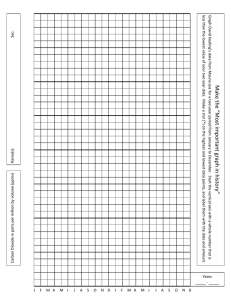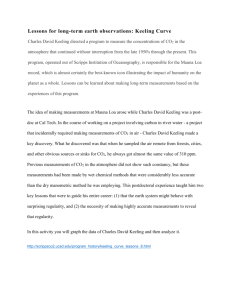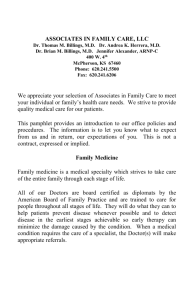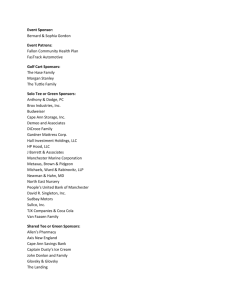Abstract/Summary
advertisement
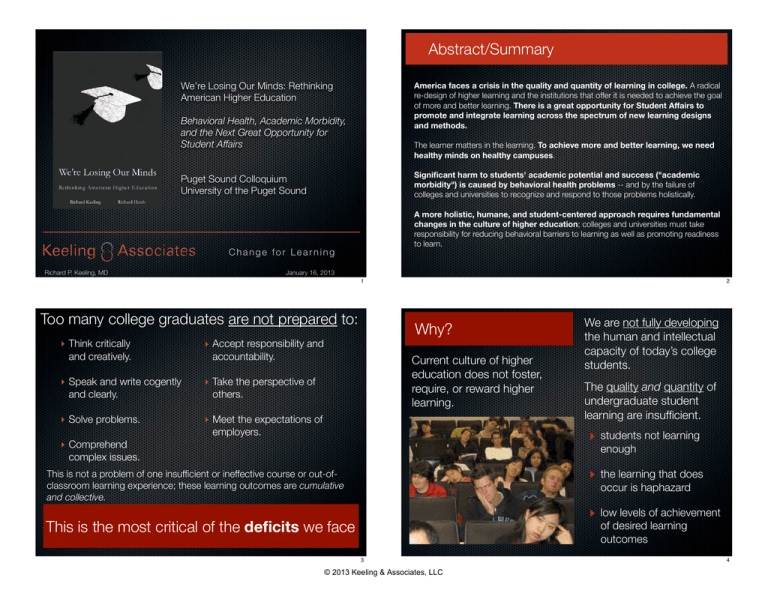
Abstract/Summary We’re Losing Our Minds: Rethinking American Higher Education America faces a crisis in the quality and quantity of learning in college. A radical re-design of higher learning and the institutions that offer it is needed to achieve the goal of more and better learning. There is a great opportunity for Student Affairs to promote and integrate learning across the spectrum of new learning designs and methods. Behavioral Health, Academic Morbidity, and the Next Great Opportunity for Student Affairs The learner matters in the learning. To achieve more and better learning, we need healthy minds on healthy campuses. Significant harm to students' academic potential and success ("academic morbidity") is caused by behavioral health problems -- and by the failure of colleges and universities to recognize and respond to those problems holistically. Puget Sound Colloquium University of the Puget Sound A more holistic, humane, and student-centered approach requires fundamental changes in the culture of higher education; colleges and universities must take responsibility for reducing behavioral barriers to learning as well as promoting readiness to learn. Change for Learning Richard P. Keeling, MD January 16, 2013 1 Too many college graduates are not prepared to: ‣ Think critically and creatively. ‣ Accept responsibility and accountability. ‣ Speak and write cogently and clearly. ‣ Take the perspective of others. ‣ Solve problems. ‣ Meet the expectations of employers. 2 Why? Current culture of higher education does not foster, require, or reward higher learning. ‣ Comprehend complex issues. This is not a problem of one insufficient or ineffective course or out-ofclassroom learning experience; these learning outcomes are cumulative and collective. This is the most critical of the deficits we face 3 © 2013 Keeling & Associates, LLC We are not fully developing the human and intellectual capacity of today’s college students. The quality and quantity of undergraduate student learning are insufficient. ‣ students not learning enough ‣ the learning that does occur is haphazard ‣ low levels of achievement of desired learning outcomes 4 Spellings Commission Report [2006] Evidence “...disturbing signs that many students who do earn degrees have not actually mastered the reading, writing, and thinking skills we expect of college graduates. 75% 25% 2 Year Students 50% 50% 4 Year Students % below minimum levels of proficiency: summarizing competing arguments in editorials, comparing credit card offers. And: only 20% of 4-year college graduates had basic quantitative skills. [2006] Over the past decade, literacy among college graduates has actually declined.” 5 2010 ‣ 45% "did not demonstrate any significant improvement in learning" during the first two years of college. ‣ 36% "did not demonstrate any significant improvement in learning" over four years of college. ‣ Students improved on average only 0.18 standard deviations over the first two years of college and 0.47 over four years. 6 ‣ Students majoring in liberal arts fields show "significantly higher gains in critical thinking, complex reasoning, and writing skills over time than students in other fields of study." ‣ Students majoring in 2010 7 © 2013 Keeling & Associates, LLC business, education, social work and communications showed the smallest gains. 8 Disproportionately rising costs, excessive student debt, low rates of completion, inefficiency, “administrative bloat,” perceived low faculty productivity, failings of the tenure system, insufficient accountability, ineffective methods of comparing or ranking schools, grade inflation... 9 10 Endowment Growth Costs are outrageous and completion is vital, but the critical problem is learning. Winning Athletic Teams Magazine Rankings Star Faculty / Researchers Overall Research Productivity Many institutions of higher education do not deliver enough value to justify their costs. Enrollment and Retention Happy/Content Parents Simply reducing those costs or improving the efficiency of their operations and programs would only produce institutions that fail to produce higher learning with greater efficiency. Buildings and Grounds Public Relations/Image Community Relationships Student Experience Learning How Did This Happen? Priorities 11 © 2013 Keeling & Associates, LLC 12 August 29, 2010 30 Ways to Rate a College By Alex Richards & Ron Coddington Much of the emphasis is on “input measures”such as student selectivity, faculty-student ratio, and retention of freshmen. Institutions of Higher Education Except for graduation rates, almost no “outcome measures,” such as whether a student comes out prepared to succeed in the work force, are used. For-Profit Corporations Rankings Questions of Purpose and Mission 13 14 ‣ Value on Throughput Getting enough students: recruited admitted Students whose classes reflect high expectations (more than 40 pages of reading a week and more than 20 pages of writing a semester) gained more than other students. “If we consider [various] faculty attributes simultaneously, high expectations stand out as the only relevant factor...when faculty have high expectations, students learn more.” p. 93 enrolled retained NSSE and other studies show that on average undergraduate students are doing a mere 10 to 15 hours per week of homework; in 1961, the average college student spent 24 hours per week studying, while current students spend only half that time. graduated educated (?) 15 © 2013 Keeling & Associates, LLC 16 Learning Experiences Not Integrated Cumulative & Collective Cumulative & Collective Academic First-year experience and transition programs Coherent curriculum Active and experiential learning Integration of classroom & other learning experiences Time on task Intensive writing Frequent faculty contact Frequent feedback Engagement with diversity Diversity of ways of knowing and learning High expectations Learning Experiences Not Integrated Integration of knowledge, experience, skills Student Affairs Coherent curriculum Active and experiential learning Integration of classroom & other learning experiences Learning is achieved across the whole of the Intensive writing experience...and the more tightly integrated learning experiences are, the better. Student Affairs Timecollege on task Student Engagement Institutional Commitment Frequent faculty contact Frequent feedback Engagement with diversity Diversity of ways of knowing and learning High expectations Integration of knowledge, experience, skills 17 But... Learning is a complex, dynamic interaction among students and others, new knowledge, experiences, events, and their own history and aspirations..... Academic First-year experience and transition programs Student Engagement Institutional Commitment 18 But... Epistemology, Psychology, Adult Learning Theory, Scholarship of Teaching and Learning, “Real World” Experience, Neurosciences Learners each construct knowledge by making meaning from the raw materials of content and their experience Learning integrates (1) the acquisition, integration, and application of knowledge with (2) the development and maturation of the person Learning is a complex, dynamic interaction among The shift has students and been others,from new a view knowledge, that learningexperiences, is the acquisition events, and their own history of and desired knowledge and aspirations..... behaviors to a view that Learners each construct learning is the construction of knowledge by making knowledge bythe theraw individual, meaning from materials of content construction that isand mediated their experience by the context of the learning, (1) theand the theLearning social integrates environment, acquisition, integration, and prior knowledge of the learner. application of knowledge with Epistemology, Psychology, Adult Learning Theory, Scholarship of Teaching and Learning, “Real World” Experience, Neurosciences (2) the development and maturation of the person 19 © 2013 Keeling & Associates, LLC 20 But... Learning is a complex, dynamic interaction among The shift has students and been others,from new a view knowledge, that learningexperiences, is the acquisition events, and their own history of and desired knowledge and aspirations..... behaviors to a view that Learners each construct learning is the construction of knowledge by making knowledge bythe theraw individual, meaning from materials of content construction that isand mediated their experience by the context of the learning, (1) theand the theLearning social integrates environment, acquisition, integration, and prior knowledge of the learner. application of knowledge with Epistemology, Psychology, Adult Learning Theory, Scholarship of Teaching and Learning, “Real World” Experience, Neurosciences (2) the development and maturation of the person But... Learning happens always and Epistemology, Psychology, Learning is a complex, everywhere, inside and outside the dynamic interaction among Adult Learning Theory, The shift has been from a view students and others, new of Teaching and classroom, on and Scholarship off campus... knowledge, that learningexperiences, is the acquisition events, and their own history Learning, “Real World” of and desired knowledge and aspirations..... Experience, Neurosciences behaviors to a view that Learners each construct learning is the construction of knowledge by making knowledge bythe theraw individual, meaning from materials of content construction that isand mediated their experience by the context of the learning, (1) theand the theLearning social integrates environment, acquisition, integration, and prior knowledge of the learner. application of knowledge with Students blend new knowledge from many sources in ways and with effectiveness that are deeply influenced by the context of their lives...including their challenges, (2) the development and health, and expectations. maturation ofwell-being, the person 21 22 23 24 Readiness to Learn Higher learning demands the participation of the whole person, encumbered or elevated as he or she may be by life and its events and experiences. © 2013 Keeling & Associates, LLC Behavioral Health & Learning: A Sample National Epidemiologic Study on Alcohol and Related Conditions [2008]: nearly 50% of college-attending students had a psychiatric disorder -- primarily alcohol use disorder -- in the past year; fewer than 25% of students with any psychiatric disorder sought treatment. University of Michigan Persistence of Mental Health Problems Study [2009]: Over half of students had a mental health problem in first year; 60% two years later. Although most recognized need for treatment, fewer than 50% sought it. Consortium Mental Health and Counseling Study [NASPA and Center for the Study of Collegiate Mental Health, Penn State; 2010]: 8-16% frequency of feeling isolated/alone or sad all the time; 21-24% hard to stay motivated for class or hard to concentrate. National College Health Assessment [2004-2011]: using frequency X level of threat to academic success calculation, most important health issues affecting academic success of undergraduates and medical students = stress, depression/anxiety/SAD, relationship problems, concern for troubled friend/family member, and death of friend/family member. College Alcohol Study [1993-1999]: Net total effect of alcohol consumption on GPA is negative; main effect is via a reduction in the hours spent studying. Reducing alcohol consumption levels among college students may result in improved study habits. Not Depressed Clinical Depression Air Force Academy [2010]: Drinking caused statistically significant reductions in academic performance, especially for higher-performing students. 25 Definitive Study 26 The Lost Opportunity: True Higher Learning University of Michigan [2009]: Healthy Minds Study; 56% response rate from a broad random sample of undergraduate and graduate students at Michigan. Main points: • • Depression has a significant negative association with GPA (reduction by 0.17) • • • Anxiety without depression not associated with GPA • Findings true for men and women, undergraduates and graduate students, and not modified by financial status or exercise Co-occurrence of depression and anxiety associated with significant further drop in GPA (reduction by total 0.40) Depression associated with higher likelihood of dropping out of university All nine primary symptoms of depression (DSM-IV and PHQ) are independently and negatively associated with GPA The student who graduates should not be the same person as the one who started college... Eisenberg, Golbestein, and Hunt. Mental Health and Academic Success in College. The B.E. Journal of Economic Analysis and Policy 2009: 9(1): 1-35. 27 © 2013 Keeling & Associates, LLC 28 Higher Learning is Transformative What Must Be Done? ‣ Perspective change ‣ Embraces but transcends content comprehension Making learning the top priority ‣ More than accumulative ...significant, not incremental, changes in ‣ Fundamentally developmental -existential crises concepts, policies, and practices throughout the academy ‣ Construction of meaning by each learner will require change in culture. ‣ Personal / social identity formation ‣ Cultural immersion 29 30 Core Principles: A Culture of Higher Learning Rethinking higher education means questioning the entire pantheon of: ‣ Intentional emphasis on learning ‣ Sufficient time for study, reflection, preparation ‣ Engagement of students with full-time educators, inside and outside classroom ‣ assumptions ‣ organizational structures ‣ Holistic learning ‣ principles ‣ reward systems ‣ Cumulative and collective learning ‣ priorities ‣ usual and customary ‣ Coherent and integrated learning ‣ values practices ‣ Challenging and rigorous standards and expectations, inside and outside classroom ...that are the common foundation for undergraduate programs. ‣ Advising, mentoring, and counseling as teaching ‣ Assessment as teaching and learning ‣ General education through four years ‣ Aligned reward systems 31 © 2013 Keeling & Associates, LLC 32 Taking responsibility • Readiness to learn • Removing barriers to learning • Integrating learning in and out of classroom • Collective, cumulative I understand the argument that the university can’t do everything. Academic courses, it goes, are for the mind. Let the home and the church and the psychotherapist and the athletic program attend to the spirit and the body and the rest…We can’t be therapists and doctors and spiritual directors, too. What I am asking for is a more holistic approach to learning, a disciplinary training for people who teach in college that takes into account the fact that we are educators of whole human beings, a form of higher education that would take responsibility for emergence of an integrated person. goals • Developmental emphasis Core/Central Role for Student Affairs 33 34 Ottawa Charter for Promotion Taking Responsibility forHealth the Emergence of an Integrated Person: Ottawa Charter for Health Promotion [1986] Community/ Group Health promotion is the process of enabling people to increase control over, and to improve, their health. To reach a state of complete physical, mental and social well-being, an individual or group must be able to identify and to realize aspirations, to satisfy needs, and to change or cope with the environment. Individual/ Personal Taking responsibility for the development of an integrated person Health is, therefore, seen as a resource for everyday life, not the objective of living. Health is a positive concept emphasizing social and personal resources, as well as physical capacities. Therefore, health promotion is not just the responsibility of the health sector, but goes beyond healthy life-styles to well-being. Capacity/ Agency 35 © 2013 Keeling & Associates, LLC 36 Community/ Group Individual/ Personal Community/ Group Individual/ Personal interdependence connectedness inclusion resilience reflection identity purpose Integrated Person Capacity/ Agency Capacity/ Agency health ability adaptation creation 37 Taking Responsibility 38 Taking Responsibility First Quality Research -- Epidemiologic, Clinical, Treatment Outcomes, and Academic Outcomes: insufficient data currently to clearly map epidemiologic, clinical, or academic trends in mental health. Serious, Integrated Approach in Policy and Practice: health is not “just the responsibility of the health sector”; all parts of a college/university must “work together towards a health care system which contributes to the pursuit of health.” [Ottawa Charter, 1986]. Implications: professional development for faculty and staff, attitudinal and cultural leadership from senior officers, reallocation of resources to promote readiness to learn and relieve/ameliorate barriers to learning. Want Students to be Integrated Persons? Integrate Their Experience and Learning. Reconsider the traditional organization of post-secondary institutions, including the division of student learning experiences into academic and non-academic sectors; integrate classroom and out-of-classroom learning experiences throughout the student experience. Student-Centeredness/Holistic Learning and Experience: Focus on understanding all the factors that promote or impair learning and on intervening wherever possible to strengthen students and their communities; raise the standards for “wherever possible” to mean more than “if convenient.” Learning as Touchstone for Decision-Making: Assess all questions of resources, priorities, strategy, and tactics based on their projected effects on the quality and quantity of learning and their impact on the potential for a healthy campus community. Emphasis on Creating and Sustaining Supportive Environments: Addressing sources of stress and dysfunction is a better investment than treating them. Ecological models of health arise from the importance of environmental and cultural factors in determining behaviors and promoting symptoms. 39 © 2013 Keeling & Associates, LLC 40 Revolutionary Thinking Stop... Traditional Expecting that all students who face barriers to learning will selfidentify and seek services or treatment. Most will not. Assume they exist, are among the community, and have needs. Demanding/expecting heroism -- especially, thinking of heroic actions as ordinary and possible, blaming students for not taking those actions, or not recognizing what heroism is and requires. As in: “Relax,” or “Get over it.” Working only on the “personal skills” part of health promotion. Doing that reinforces the need for heroism, and the assumption that heroism is ordinary and possible. Depending on “quick fixes,” tool-kits, and easy answers. Creating the conditions that promote healthy minds on healthy campuses requires cultural change, cultural and social tools, political acumen, and serious engagement with students as integrating human beings; it will not be efficient, fast, or cheap. Adaptive Radical Some students have psychological “problems” and/or addictions; postsecondary institutions should provide specific, limited services to respond to their concerns. The prevalence and intensity of psychological concerns demands an increase in the volume, diversity, and accessibility of services. Responding to the “problems” of certain students is an insufficient and potentially dangerous institutional policy; questions of the quality of the learning and living environment, campus culture, and human flourishing must be addressed. Resources are scarce; services must be allocated to address the most pressing needs, and students must seek care that falls beyond the capacity of the institution from other sources. Institutions must provide more resources in order to reduce risk, prevent incidents, and ensure that the most acute, urgent, and critical problems are recognized and addressed. This may require reducing outreach, liaison, and low-intensity services. Competition for resources should not occur in isolation within the realm of counseling services; institutions may reallocate resources currently devoted to other purposes to strengthen campus culture and support the creation of health campus communities. Students who have psychological concerns or addictions may experience academic, social, and personal difficulty. Improved service models may make it easier to recognize and respond to students with psychological concerns or addictions: surveillance, screening, “early alert” programs. Many students may at various times not be ready to learn, and/or may encounter barriers to learning; a systemic, community-based approach to creating strong campus culture is needed. “Healthy campus” models can provide an “Healthy campus” is an abstract concept ecological perspective that emphasizes that offers noble, general goals that inter-dependence, community values and primarily focus on certain elements of norms, and collaboration within the health status and health behaviors. campus community. A “healthy campus” should be defined in positive ways that focus on strong developmental outcomes, flourishing at both individual and community levels, and new criteria and metrics. 41 42 Commitment Change Culture, Change Outcomes Courage Resiliency It is the synchronous coordination of all of these efforts that drives students toward the achievement of higher learning. Community Change 43 © 2013 Keeling & Associates, LLC 44 Change for Learning www.KeelingAssociates.com 411 Lafayette St., 6th Floor New York, NY 10003 Phone 212-229-4750 45 © 2013 Keeling & Associates, LLC
